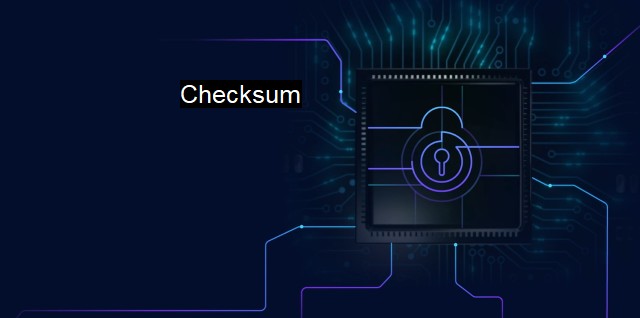What is Checksum?
Checksums in Cybersecurity: Verifying Authenticity and Preventing Malware Threats in Electronic File Management
In the context of cybersecurity and antivirus utilities, the term "checksum" refers to a simple yet remarkably effective method used for ensuring the integrity and authenticity of data. a checksum is a computed value obtained from a set of data—a file, a message, or a block of data—which is unique to that data content. It's like a data-digest or a fingerprint of the original data set which, alongside the actual data, serves a special purpose in regards to information security.Discussing a checksum is not complete without talking about the process through which it is obtained which is known as the checksum algorithm. This algorithm processes data to generate a relatively small, fixed size bit string, which is the checksum value. There are many different types of checksum algorithms, including cyclic redundancy check (CRC), checksums in Transmission Control Protocol (TCP) and Internet Protocol (IP), to mention a few.
The checksum function can be compared to a mathematical problem where an operand performs an operation on data to generate a unique result. If you know the original data and the operation, you can always get that unique result no matter how many times you perform the operation. This continual consistency makes checksums a reliable method for verifying the fidelity of electronic data.
Checksums play a critical role in protecting systems from malicious threats by enabling infallible data verification. Here they serve exactly the same purpose to check the integrity and consistency of files transmitted over a network or stored in a database. When data is sent across a network, there is a risk that it may be interfered with or corrupted accidentally by network errors or deliberately by cyber attackers. In this regard, the checksum of the data file is calculated before transmission and sent along with the file. Upon receipt of the file, the recipient system calculates the checksum using the same algorithm and compares the calculated checksum with the one received. If the two values match, it means the data has not been corrupted or interfered with. If they do not match, it means the data has undergone some changes and thus may not be authentic, compromised or entirely corrupted.
Checksums are also used in antivirus applications to scan for known viruses. Typical behaviour of malware is to attach itself to files and modify them, changing their size and content. The antivirus software periodically calculates checksums for vital system files and compares these with previously calculated checksums that were stored at a safer place. If the current checksum does not match the previous one, it means that the file may have been altered or infected with a virus, introducing the need for further investigation.
Persistently calibrated checksums provide an additional layer of network security. They are reasonably effective in denying any undetected alterations to vital files thus protecting the system from potential threats. it should be stated that checksum only provides security against accidental errors or moderate attacks. Sophisticated attacks, perpetrated with an intention to tamper the checksum along with the file, can deceive a checksum-based system.
Even though checksums are not cryptographically secure, they still form an integral part of cybersecurity efforts and have proven incredibly useful in detecting data alteration. They offer a simple solution to a problem that can have far-reaching effects if not bested, making them a formidable tool in the quest to uphold data integrity.

Checksum FAQs
What is a checksum?
A checksum is a mathematical value that is assigned to a data file. It helps in validating the data and detecting any errors or modifications that may have occurred during transmission or storage. In cybersecurity and antivirus, checksums are used to verify the integrity and authenticity of software files.How does a checksum work?
A checksum is computed by applying a specific algorithm to the data in the file. The result is a fixed-length value that reflects the contents of the file. When the file is received or accessed, the same algorithm is applied to the data, and the resulting value is compared to the original checksum. If the two values match, the data is considered valid and unchanged. If they do not match, the data has been modified or corrupted.Why is a checksum important for cybersecurity?
A checksum is important for cybersecurity because it helps prevent tampering and ensures that the data has not been altered or corrupted. In antivirus software, checksums are used to detect and prevent the spread of malware. By comparing the checksum of a file against a known good value, antivirus software can identify and quarantine malicious files.Can a checksum be forged or manipulated?
It is possible to forge or manipulate a checksum, but it is not easy. The checksum algorithm is designed to be difficult to reverse-engineer, so it is not easy to create a new checksum that matches the original. However, sophisticated attackers may use techniques such as hash collisions to generate a fake checksum that matches the original. In general, though, checksums are a reliable tool for verifying the integrity and authenticity of data.| | A | | | B | | | C | | | D | | | E | | | F | | | G | | | H | | | I | | | J | | | K | | | L | | | M | |
| | N | | | O | | | P | | | Q | | | R | | | S | | | T | | | U | | | V | | | W | | | X | | | Y | | | Z | |
| | 1 | | | 2 | | | 3 | | | 4 | | | 7 | | | 8 | | |||||||